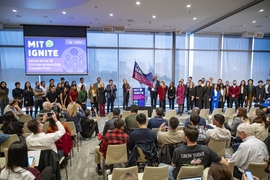Natural language conveys ideas, actions, information, and intent through context and syntax; further, there are volumes of it contained in databases. This makes it an excellent source of data to train machine-learning systems on. Two master's of engineering students in the 6A MEng Thesis Program at MIT, Irene Terpstra ’23 and Rujul Gandhi ’22, are working with mentors in the MIT-IBM Watson AI Lab to use this power of natural language to build AI systems.
As computing is becoming more advanced, researchers are looking to improve the hardware that they run on; this means innovating to create new computer chips. And, since there is literature already available on modifications that can be made to achieve certain parameters and performance, Terpstra and her mentors and advisors Anantha Chandrakasan, MIT School of Engineering dean and the Vannevar Bush Professor of Electrical Engineering and Computer Science, and IBM’s researcher Xin Zhang, are developing an AI algorithm that assists in chip design.
“I'm creating a workflow to systematically analyze how these language models can help the circuit design process. What reasoning powers do they have, and how can it be integrated into the chip design process?” says Terpstra. “And then on the other side, if that proves to be useful enough, [we’ll] see if they can automatically design the chips themselves, attaching it to a reinforcement learning algorithm.”
To do this, Terpstra’s team is creating an AI system that can iterate on different designs. It means experimenting with various pre-trained large language models (like ChatGPT, Llama 2, and Bard), using an open-source circuit simulator language called NGspice, which has the parameters of the chip in code form, and a reinforcement learning algorithm. With text prompts, researchers will be able to query how the physical chip should be modified to achieve a certain goal in the language model and produced guidance for adjustments. This is then transferred into a reinforcement learning algorithm that updates the circuit design and outputs new physical parameters of the chip.
“The final goal would be to combine the reasoning powers and the knowledge base that is baked into these large language models and combine that with the optimization power of the reinforcement learning algorithms and have that design the chip itself,” says Terpstra.
Rujul Gandhi works with the raw language itself. As an undergraduate at MIT, Gandhi explored linguistics and computer sciences, putting them together in her MEng work. “I’ve been interested in communication, both between just humans and between humans and computers,” Gandhi says.
Robots or other interactive AI systems are one area where communication needs to be understood by both humans and machines. Researchers often write instructions for robots using formal logic. This helps ensure that commands are being followed safely and as intended, but formal logic can be difficult for users to understand, while natural language comes easily. To ensure this smooth communication, Gandhi and her advisors Yang Zhang of IBM and MIT assistant professor Chuchu Fan are building a parser that converts natural language instructions into a machine-friendly form. Leveraging the linguistic structure encoded by the pre-trained encoder-decoder model T5, and a dataset of annotated, basic English commands for performing certain tasks, Gandhi’s system identifies the smallest logical units, or atomic propositions, which are present in a given instruction.
“Once you’ve given your instruction, the model identifies all the smaller sub-tasks you want it to carry out,” Gandhi says. “Then, using a large language model, each sub-task can be compared against the available actions and objects in the robot’s world, and if any sub-task can’t be carried out because a certain object is not recognized, or an action is not possible, the system can stop right there to ask the user for help.”
This approach of breaking instructions into sub-tasks also allows her system to understand logical dependencies expressed in English, like, “do task X until event Y happens.” Gandhi uses a dataset of step-by-step instructions across robot task domains like navigation and manipulation, with a focus on household tasks. Using data that are written just the way humans would talk to each other has many advantages, she says, because it means a user can be more flexible about how they phrase their instructions.
Another of Gandhi’s projects involves developing speech models. In the context of speech recognition, some languages are considered “low resource” since they might not have a lot of transcribed speech available, or might not have a written form at all. “One of the reasons I applied to this internship at the MIT-IBM Watson AI Lab was an interest in language processing for low-resource languages,” she says. “A lot of language models today are very data-driven, and when it’s not that easy to acquire all of that data, that’s when you need to use the limited data efficiently.”
Speech is just a stream of sound waves, but humans having a conversation can easily figure out where words and thoughts start and end. In speech processing, both humans and language models use their existing vocabulary to recognize word boundaries and understand the meaning. In low- or no-resource languages, a written vocabulary might not exist at all, so researchers can’t provide one to the model. Instead, the model can make note of what sound sequences occur together more frequently than others, and infer that those might be individual words or concepts. In Gandhi’s research group, these inferred words are then collected into a pseudo-vocabulary that serves as a labeling method for the low-resource language, creating labeled data for further applications.
The applications for language technology are “pretty much everywhere,” Gandhi says. “You could imagine people being able to interact with software and devices in their native language, their native dialect. You could imagine improving all the voice assistants that we use. You could imagine it being used for translation or interpretation.”










